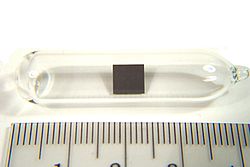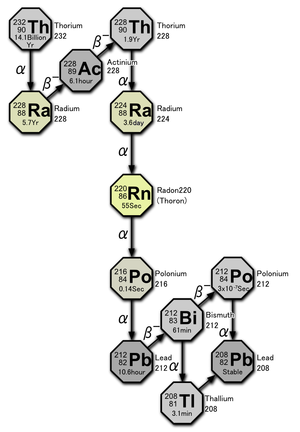From Wikipedia, the free encyclopedia

A sample of thorium.
The thorium fuel cycle claims several potential advantages over a uranium fuel cycle, including thorium's greater abundance, superior physical and nuclear properties, better resistance to nuclear weapons proliferation[1][2][3] and reduced plutonium and actinide production.[3]
Contents
History
Concerns about the limits of worldwide uranium resources motivated initial interest in the thorium fuel cycle.[4] It was envisioned that as uranium reserves were depleted, thorium would supplement uranium as a fertile material. However, for most countries uranium was relatively abundant and research in thorium fuel cycles waned. A notable exception was India's three-stage nuclear power programme.[5] In the twenty-first century thorium's potential for improving proliferation resistance and waste characteristics led to renewed interest in the thorium fuel cycle.[6][7][8]At Oak Ridge National Laboratory in the 1960s, the Molten-Salt Reactor Experiment used 233U as the fissile fuel as an experiment to demonstrate a part of the Molten Salt Breeder Reactor that was designed to operate on the thorium fuel cycle. Molten Salt Reactor (MSR) experiments assessed thorium's feasibility, using thorium(IV) fluoride dissolved in a molten salt fluid which eliminated the need to fabricate fuel elements. The MSR program was defunded in 1976 after its patron Alvin Weinberg was fired.[9]
In 2006, Carlo Rubbia proposed the concept of an energy amplifier or "accelerator driven system" (ADS), which he saw as a novel and safe way to produce nuclear energy that exploited existing accelerator technologies. Rubbia's proposal offered the potential to incinerate high-activity nuclear waste and produce energy from natural thorium and depleted uranium.[10][11]
Kirk Sorensen, former NASA scientist and Chief Nuclear Technologist at Teledyne Brown Engineering, has been a long time promoter of thorium fuel cycle and particularly liquid fluoride thorium reactors (LFTRs). He first researched thorium reactors while working at NASA, while evaluating power plant designs suitable for lunar colonies. In 2006 Sorensen started "energyfromthorium.com" to promote and make information available about this technology.[12]
A 2011 MIT study concluded that, although there is little in the way of barriers to a thorium fuel cycle, with current or near term light-water reactor designs there is also little incentive for any significant market penetration to occur. As such they conclude there is little chance of thorium cycles replacing conventional uranium cycles in the current nuclear power market, despite the potential benefits.[13]
Nuclear reactions with thorium
In the thorium cycle, fuel is formed when 232Th captures a neutron (whether in a fast reactor or thermal reactor) to become 233Th. This normally emits an electron and an anti-neutrino (ν) by β− decay to become 233Pa. This then emits another electron and anti-neutrino by a second β− decay to become 233U, the fuel:Fission product wastes
Nuclear fission produces radioactive fission products which can have half-lives from days to greater than 200,000 years. According to some toxicity studies,[14] the thorium cycle can fully recycle actinide wastes and only emit fission product wastes, and after a few hundred years, the waste from a thorium reactor can be less toxic than the uranium ore that would have been used to produce low enriched uranium fuel for a light water reactor of the same power. Other studies assume some actinide losses and find that actinide wastes dominate thorium cycle waste radioactivity at some future periods.[15]Actinide wastes
In a reactor, when a neutron hits a fissile atom (such as certain isotopes of uranium), it either splits the nucleus or is captured and transmutes the atom. In the case of 233U, the transmutations tend to produce useful nuclear fuels rather than transuranic wastes. When 233U absorbs a neutron, it either fissions or becomes 234U. The chance of fissioning on absorption of a thermal neutron is about 92%; the capture-to-fission ratio of 233U, therefore, is about 1:10 — which is better than the corresponding capture vs. fission ratios of 235U (about 1:6), or 239Pu (about 1:2), or 241Pu (about 1:4).[4] The result is less transuranic waste than in a reactor using the uranium-plutonium fuel cycle.| 230Th | → | 231Th | ← | 232Th | → | 233Th | (White actinides: t½<27d) | |||||||
| ↓ | ↓ | |||||||||||||
| 231Pa | → | 232Pa | ← | 233Pa | → | 234Pa | (Colored : t½>68y) | |||||||
| ↑ | ↓ | ↓ | ↓ | |||||||||||
| 231U | ← | 232U | ↔ | 233U | ↔ | 234U | ↔ | 235U | ↔ | 236U | → | 237U | ||
| ↓ | ↓ | ↓ | ↓ | |||||||||||
| (Fission products with t½<90y or t½>200ky) | 237Np | |||||||||||||
However, the 231Pa (with a half-life of 3.27×104 years) formed via (n,2n) reactions with 232Th (yielding 231Th that decays to 231Pa), while not a transuranic waste, is a major contributor to the long term radiotoxicity of spent nuclear fuel.
Uranium-232 contamination
Uranium-232 is also formed in this process, via (n,2n) reactions between fast neutrons and 233U, 233Pa, and 232Th:232U decays to 228Th where it joins the decay chain of 232Th
Advantages as a nuclear fuel
Thorium is estimated to be about three to four times more abundant than uranium in the Earth's crust,[16] although present knowledge of reserves is limited. Current demand for thorium has been satisfied as a by-product of rare-earth extraction from monazite sands. Also, unlike uranium, mined thorium consists of a single isotope (232Th). Consequently, it is useful in thermal reactors without the need for isotope separation.Thorium-based fuels exhibit several attractive properties relative to uranium-based fuels. The thermal neutron absorption cross section (σa) and resonance integral (average of neutron cross sections over intermediate neutron energies) for 232Th are about three times and one third of the respective values for 238U; consequently, fertile conversion of thorium is more efficient in a thermal reactor. Also, although the thermal neutron fission cross section (σf) of the resulting 233U is comparable to 235U and 239Pu, it has a much lower capture cross section (σγ) than the latter two fissile isotopes, providing fewer non-fissile neutron absorptions and improved neutron economy. Finally, the ratio of neutrons released per neutron absorbed (η) in 233U is greater than two over a wide range of energies, including the thermal spectrum; as a result, thorium-based fuels can be the basis for a thermal breeder reactor.[4]
Thorium-based fuels also display favorable physical and chemical properties which improve reactor and repository performance. Compared to the predominant reactor fuel, uranium dioxide (UO
2), thorium dioxide (ThO
2) has a higher melting point, higher thermal conductivity, and lower coefficient of thermal expansion. Thorium dioxide also exhibits greater chemical stability and, unlike uranium dioxide, does not further oxidize.[4]
Because the 233U produced in thorium fuels is inevitably contaminated with 232U, thorium-based used nuclear fuel possesses inherent proliferation resistance. 232U can not be chemically separated from 233U and has several decay products which emit high energy gamma radiation. These high energy photons are a radiological hazard that necessitate the use of remote handling of separated uranium and aid in the passive detection of such materials. 233U can be denatured by mixing it with natural or depleted uranium, requiring isotope separation before it could be used in nuclear weapons.
The long term (on the order of roughly 103 to 106 years) radiological hazard of conventional uranium-based used nuclear fuel is dominated by plutonium and other minor actinides, after which long-lived fission products become significant contributors again. A single neutron capture in 238U is sufficient to produce transuranic elements, whereas six captures are generally necessary to do so from 232Th. 98–99% of thorium-cycle fuel nuclei would fission at either 233U or 235U, so fewer long-lived transuranics are produced. Because of this, thorium is a potentially attractive alternative to uranium in mixed oxide (MOX) fuels to minimize the generation of transuranics and maximize the destruction of plutonium.[17]
Disadvantages as nuclear fuel
There are several challenges to the application of thorium as a nuclear fuel, particularly for solid fuel reactors:Unlike uranium, natural thorium contains no fissile isotopes; fissile material, generally 233U, 235U or plutonium, must be added to achieve criticality. This, along with the high sintering temperature necessary to make thorium-dioxide fuel, complicates fuel fabrication. Oak Ridge National Laboratory experimented with thorium tetrafluoride as fuel in a molten salt reactor from 1964–1969, which was far easier to both process and separate from contaminants that slow or stop the chain reaction.
In an open fuel cycle (i.e. utilizing 233U in situ), higher burnup is necessary to achieve a favorable neutron economy. Although thorium dioxide performed well at burnups of 170,000 MWd/t and 150,000 MWd/t at Fort St. Vrain Generating Station and AVR respectively,[4] challenges complicate achieving this in light water reactors (LWR), which compose the vast majority of existing power reactors.
In a once-through thorium fuel cycle the residual 233U is long lived radioactive waste.
Another challenge associated with the thorium fuel cycle is the comparatively long interval over which 232Th breeds to 233U. The half-life of 233Pa is about 27 days, which is an order of magnitude longer than the half-life of 239Np. As a result, substantial 233Pa develops in thorium-based fuels. 233Pa is a significant neutron absorber, and although it eventually breeds into fissile 235U, this requires two more neutron absorptions, which degrades neutron economy and increases the likelihood of transuranic production.
Alternatively, if solid thorium is used in a closed fuel cycle in which 233U is recycled, remote handling is necessary for fuel fabrication because of the high radiation levels resulting from the decay products of 232U. This is also true of recycled thorium because of the presence of 228Th, which is part of the 232U decay sequence. Further, unlike proven uranium fuel recycling technology (e.g. PUREX), recycling technology for thorium (e.g. THOREX) is only under development.
Although the presence of 232U complicates matters, there are public documents showing that 233U has been used once in a nuclear weapon test. The United States tested a composite 233U-plutonium bomb core in the MET (Military Effects Test) blast during Operation Teapot in 1955, though with much lower yield than expected.[18]
Though thorium-based fuels produce far less long-lived transuranics than uranium-based fuels,[14] some long-lived actinide products constitute a long term radiological impact, especially 231Pa.[15]
Advocates for liquid core and molten salt reactors such as LFTR claim that these technologies negate thorium's disadvantages present in solid fueled reactors. Since only two liquid core fluoride salt reactors have been built (the ORNL ARE and MSRE) and neither used thorium, it is hard to validate the exact benefits.[4]













No comments:
Post a Comment